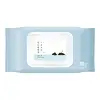What's inside
What's inside
 Key Ingredients
Key Ingredients

 Benefits
Benefits

 Ingredients Side-by-side
Ingredients Side-by-side

Water
Skin ConditioningMethylpropanediol
SolventDipropylene Glycol
HumectantPolyglyceryl-6 Caprylate
EmulsifyingSea Water
HumectantSodium Hyaluronate
HumectantSodium Acetylated Hyaluronate
HumectantHydrolyzed Hyaluronic Acid
HumectantAllantoin
Skin ConditioningDipotassium Glycyrrhizate
HumectantPanthenol
Skin ConditioningMaltodextrin
AbsorbentSodium Metabisulfite
AntioxidantProtease
ExfoliatingPolyglyceryl-4 Caprate
EmulsifyingSodium Citrate
BufferingHydroxyacetophenone
AntioxidantDecylene Glycol
Skin ConditioningLaurylpyridinium Chloride
AntimicrobialLevulinic Acid
PerfumingSodium Levulinate
Skin ConditioningDisodium EDTA
1,2-Hexanediol
Skin ConditioningCitric Acid
BufferingWater, Methylpropanediol, Dipropylene Glycol, Polyglyceryl-6 Caprylate, Sea Water, Sodium Hyaluronate, Sodium Acetylated Hyaluronate, Hydrolyzed Hyaluronic Acid, Allantoin, Dipotassium Glycyrrhizate, Panthenol, Maltodextrin, Sodium Metabisulfite, Protease, Polyglyceryl-4 Caprate, Sodium Citrate, Hydroxyacetophenone, Decylene Glycol, Laurylpyridinium Chloride, Levulinic Acid, Sodium Levulinate, Disodium EDTA, 1,2-Hexanediol, Citric Acid
Water
Skin ConditioningMethylpropanediol
SolventIsopentyldiol
HumectantPolyglyceryl-10 Laurate
Skin ConditioningSorbeth-30 Tetraoleate
EmulsifyingPolysorbate 20
EmulsifyingCitrus Aurantium Bergamia Fruit Oil
MaskingHelianthus Annuus Seed Oil
EmollientCitrus Aurantium Dulcis Peel Oil
MaskingSodium Acetylated Hyaluronate
HumectantHydrolyzed Hyaluronic Acid
HumectantHydrolyzed Sodium Hyaluronate
Skin ConditioningPotassium Hyaluronate
Skin ConditioningSodium Hyaluronate Crosspolymer
HumectantPentaerythritol
HumectantAcetic Acid
Buffering1,2-Hexanediol
Skin ConditioningCaprylic/Capric Triglyceride
MaskingCitric Acid
BufferingSodium Benzoate
MaskingChlorphenesin
AntimicrobialDisodium EDTA
Water, Methylpropanediol, Isopentyldiol, Polyglyceryl-10 Laurate, Sorbeth-30 Tetraoleate, Polysorbate 20, Citrus Aurantium Bergamia Fruit Oil, Helianthus Annuus Seed Oil, Citrus Aurantium Dulcis Peel Oil, Sodium Acetylated Hyaluronate, Hydrolyzed Hyaluronic Acid, Hydrolyzed Sodium Hyaluronate, Potassium Hyaluronate, Sodium Hyaluronate Crosspolymer, Pentaerythritol, Acetic Acid, 1,2-Hexanediol, Caprylic/Capric Triglyceride, Citric Acid, Sodium Benzoate, Chlorphenesin, Disodium EDTA
Ingredients Explained
These ingredients are found in both products.
Ingredients higher up in an ingredient list are typically present in a larger amount.
1,2-Hexanediol is a synthetic liquid and another multi-functional powerhouse.
It is a:
- Humectant, drawing moisture into the skin
- Emollient, helping to soften skin
- Solvent, dispersing and stabilizing formulas
- Preservative booster, enhancing the antimicrobial activity of other preservatives
Citric Acid is an alpha hydroxy acid (AHA) naturally found in citrus fruits like oranges, lemons, and limes.
Like other AHAs, citric acid can exfoliate skin by breaking down the bonds that hold dead skin cells together. This helps reveal smoother and brighter skin underneath.
However, this exfoliating effect only happens at high concentrations (20%) which can be hard to find in cosmetic products.
Due to this, citric acid is usually included in small amounts as a pH adjuster. This helps keep products slightly more acidic and compatible with skin's natural pH.
In skincare formulas, citric acid can:
While it can provide some skin benefits, research shows lactic acid and glycolic acid are generally more effective and less irritating exfoliants.
Most citric acid used in skincare today is made by fermenting sugars (usually from molasses). This synthetic version is identical to the natural citrus form but easier to stabilize and use in formulations.
Read more about some other popular AHA's here:
Learn more about Citric AcidDisodium EDTA plays a role in making products more stable by aiding other preservatives.
It is a chelating agent, meaning it neutralizes metal ions that may be found in a product.
Disodium EDTA is a salt of edetic acid and is found to be safe in cosmetic ingredients.
Learn more about Disodium EDTAHydrolyzed Hyaluronic Acid is a form of hyaluronic acid. It is created by the hydrolysis of hyaluronic acid with a high molecular weight. Once created, Hydrolyzed Hyaluronic Acid has a low molecular weight.
Low molecular weight HA has been shown to hydrate and increase elasticity of the skin. Increasing elasticity is also associated with reduction of wrinkle depth.
One study found topical low molecular weight hyaluronic acid may be considered for the treatment of rosacea in the adult population. However, we always recommend speaking with a professional about your skin concerns.
Hyaluronic acids are a humectant. This means they draw moisture from the air. Hyaluronic acids help moisturize, soothe, and protect the skin.
Read more about other common forms of hyaluronic acid:
Learn more about Hydrolyzed Hyaluronic AcidMethylpropanediol is a synthetic solvent and humectant.
As a solvent, it helps dissolve other ingredients, helping to evenly distribute ingredients throughout the product. This ingredient has also been shown to have antimicrobial properties which makes it a preservative booster.
Methylpropanediol is able to add a bit of moisture to the skin. It also helps other ingredients be better absorbed into the skin, such as salicylic acid.
Learn more about MethylpropanediolSodium Acetylated Hyaluronate is a type of Hyaluronic Acid.
Hyaluronic Acids help moisturize, soothe, and protect the skin.
Read about common types of Hyaluronic Acid here:
Sodium Hyaluronate
Hydrolyzed Hyaluronic Acid
Hyaluronic Acid
Water. It's the most common cosmetic ingredient of all. You'll usually see it at the top of ingredient lists, meaning that it makes up the largest part of the product.
So why is it so popular? Water most often acts as a solvent - this means that it helps dissolve other ingredients into the formulation.
You'll also recognize water as that liquid we all need to stay alive. If you see this, drink a glass of water. Stay hydrated!
Learn more about Water